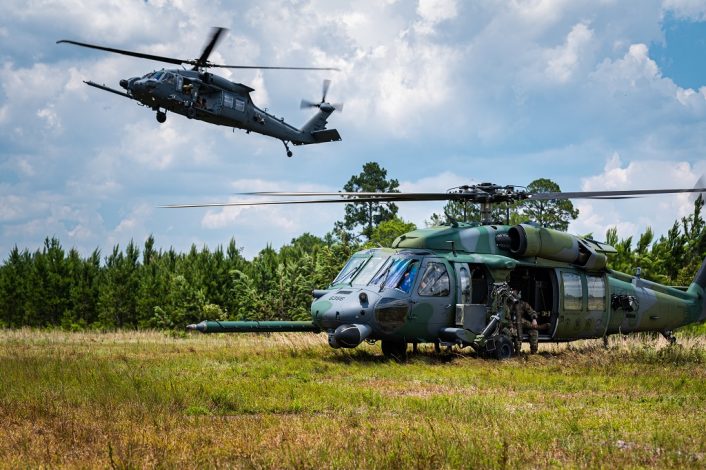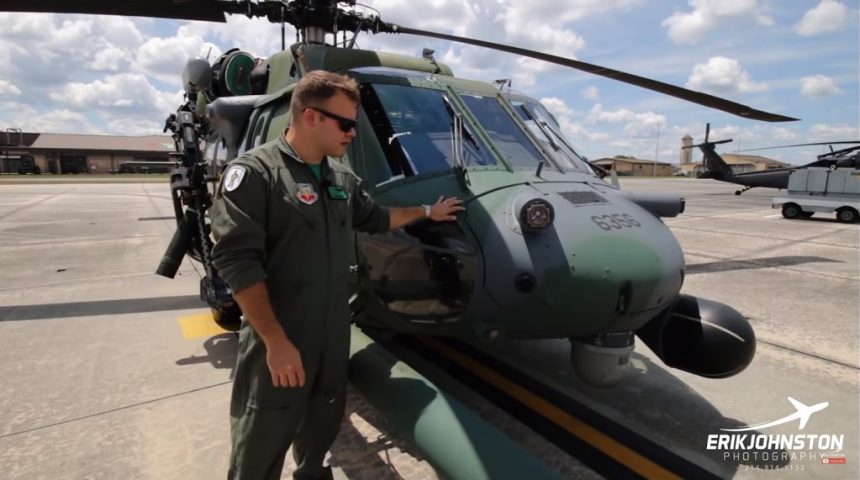41st Rescue Squadron’s pilot Captain White shares with us his extensive knowledge of the HH-60G helicopter with the freshly repainted Heritage Pave Hawk.
The Sikorsky HH-60G Pave Hawk is the U.S. Air Force’s sole rotary wing personnel recovery platform, used to perform Combat Search And Rescue (CSAR) missions when deployed abroad, but also civilian SAR when stateside. Captain Phil “Caso” White of the 41st Rescue Squadron at Moody Air Force Base, Georgia, takes us through a very detailed walkaround tour filmed by our friend Erik Johnston.
Featured in the video is Moody’s heritage tail, HH-60G 91-26356, which has been repainted in the original green and gray camouflage scheme used by the Pave Hawks when they were introduced in service. This was done to pay homage to the helicopter’s 30 years of service as it prepares to be replaced, later this year, by the new combat rescue helicopter, the HH-60W Jolly Green II.
Tail 356 will be installed in the George W. Bush Air Park at Moody AFB by September as a static display.
Moody Air Force Base #Airmen conducted a Heritage Flight with the HH-60G Pave Hawk and HH-60W Jolly Green II. The Jolly Green II will replace the Pave Hawk, which has been flown for nearly 30 years.@USAF_ACC pic.twitter.com/dnS21E31OM
— U.S. Air Force (@usairforce) June 22, 2021
The tour begins with an explanation of the sensors on the nose of the HH-60G near the retractable in-flight refueling probe mounted on the starboard side. Among those we can see the AN/AAR-47(V)2 Missile Warning System (MWS) sensors (which on some Pave Hawks are being replaced by DAIRCM) and the AN/APR-39B(V)2 Radar Warning Receiver (RWR) antennas for the self-protection, plus an infra-red (IR) probe light to help line up the helicopter for air-to-air refueling at night. Two each of the MWS sensors and RWR antennas are mounted on the tail.
This specific helicopter has been equipped with a GAU-18 .50 cal machine gun and a GAU-2 7.62×51 minigun, while usually is uses the same weapon on both sides. The GAU-18 has been the weapon of choice for deployments over the last 15 years, with its 600 API rounds (Armor Piercing Incendiary) stored in the external ammo boxes, and was chosen for its increased strike range and hitting power over the minigun. A newer variant, the GAU-21, has been tested on the HH-60G and is now the third weapon available for the HH-60W.
On the other side there is the GAU-2, which is shown later in the video. This Gatling gun has 2,700 rounds available that can be shot at either 2,000 or 4,000 rounds a minute. Unlike the .50 cal, which can strike also lightly armored vehicles, the GAU-2 can’t do much against hardened targets, however it is very precise and there is low risk of the bullets ricocheting and causing collateral damages, as mentioned by Capt. White. An interesting feature of both guns is that they can be locked in the fixed forward fire mode and operated directly by the pilots instead of the Special Mission Aviators (SMA) in the back.
A peculiar feature of the HH-60G is the presence of a hydraulically actuated rescue hoist, which is operated from inside the cabin by the right-side SMA and used whenever the helicopter can’t land to perform its mission or while working over water. The hoist has 200 feet of cable and is rated for 600 pounds, easily lifting the Pararescueman (also known as PJ) and the survivor, while the SMA guiding the cable to preserve the safety, especially when lifting a patient in a litter that could start spinning or when there is risk for the cable to be entangled in some obstacles. In the latter case, if the safety of the helicopter and crew is at serious risk, the pilots can initiate the shear system which uses a small explosive charge to drive a blade into the cable and chop it.
Another characteristic feature of the Pave Hawk are the two auxiliary fuel tanks installed inside the cabin, which double the helicopter’s range (without air refueling) with 185 gallons each. The tanks however can’t feed the engines directly, but they have two internal transfer pumps to move the fuel to the main tanks when needed. Behind the cabin there is also a fuel dump tube that can be used in case of an emergency if the helicopter loses an engine while flying at a really heavy gross weight or if the helicopter is flying a mountain rescue mission and needs more power to get to the required altitude, dumping fuel at 800 pounds per minute if there is not enough time to just burn it.
Going towards the tail there is one of the special additions made by the Air Force over the basic Black Hawk, with two forward firing AN/ALE-40 Counter Measures Dispenser System (CMDS) for flares and two others for chaff mounted facing up, so the chaffs are dispersed in the rotor creating a “chaff cloud” to have an increased chance of defeating an enemy radar. Two other ALE-40s for flares are mounted on the main landing gear, just below the external gun mounts.
Much like the Navy’s Sea Hawks, the Pave Hawk can be folded. More specifically, the rotor blades can be folded towards the rear, instead of being disassembled, and secured by brackets that can be installed at the mounting points on the tail. Also, the stabilator can be folded up on both sides and the final section of the tail can be swung to the right side of the helicopter (after folding the tail rotor’s blades), significantly shortening it for an easier transport on cargo aircraft.
Coming around to the other side the aircraft is pretty much similar to the right side, with the addition of some specific antennas, the Auxiliary Power Unit (APU) and the fuel panel used for ground refuel. An interesting system here, just beside the fuel panel, is the pneumatic ground start system that allows to start the engines with the help of another helicopter, much like when jump starting a car.
This “buddy start system” uses a large hose to transfer pneumatic power from the second helicopter (with its engines running) to the first one in the event of an APU failure in the field. In fact, much like a fighter’s jet engine, the HH-60G’s APU is started by pressurized hydraulic fluid stored in two accumulators and then it provides pneumatic power to start the engines.

The external walkaround end back at the nose, with two of the special sensors used by the Pave Hawk during rescue missions. The first one is the AN/APN-239 color weather radar which can scan up to 240 nautical miles ahead of the aircraft or, as explained by Capt. White, two hours ahead of the helicopter flying at its usual cruise speed. Even if the system is not so recent, the radar still does its job very well and allows the crew to plan ahead if they need to avoid some bad weather that might be on the route. The radar also has air-to-surface modes, allowing for example to locate a ship and mark its coordinates that the helicopter can fly to.
The second one is the AN/AAQ-29A FLIR (Forward Looking InfraRed) imaging system. Initially, it supplemented the Night Vision Googles (NVGs) at sunrise and sunset, when they usually performed less well; now it’s used mainly to pickup obstacles that might be in the flight path. A very useful function is the hover cues overlay: the pilots can point the FLIR at their landing zone (or the area where they are going to hover if working with the hoist) and flight parameters like the airspeed and instantaneous vertical velocity will be overlaid over the FLIR image, concentrating all the needed information in one spot.
After the external walkaround, the tour continues in the cockpit, which is pretty much a standard UH-60A/L cockpit with the addition of the radar display, controls for the five onboard radios and HH-60G-specific systems. More recently, a new touchscreen display, called Smart Multi-Functional Color Display (SMFCD), was installed to replace the older MFD used to display FLIR image feed moving map.
The new display also integrates a moving map, the Situational Awareness Data Link (SADL), which shows data shared by the A-10C Warthog, the HC-130 Combat King and JTACs (Joint Terminal Attack Controllers) overlaid on the map, and the Lightweight Airborne Recovery System (LARS), a special UHF radio that allows to find and send text messages to survival radios on the ground without the need for the survivor to speak and break cover before the arrival of the rescue forces.
As you might know already, the new HH-60W Jolly Green II is based off the UH-60M and will have a glass cockpit, which will provide space for even more capabilities at the pilots’ disposal. The HH-60W, whose name was chosen as a reference to the legendary tradition of the Vietnam-era HH-3E Jolly Green and HH-53 Super Jolly Green crews who pioneered the combat search and rescue mission, arrived at Moody AFB for the first time in November 2020, when the first two operational helicopters were delivered to begin the transition from the HH-60G. Even if the helicopter’s name changed, the mission remains the same: “These Things We Do, That Others May Live”.









